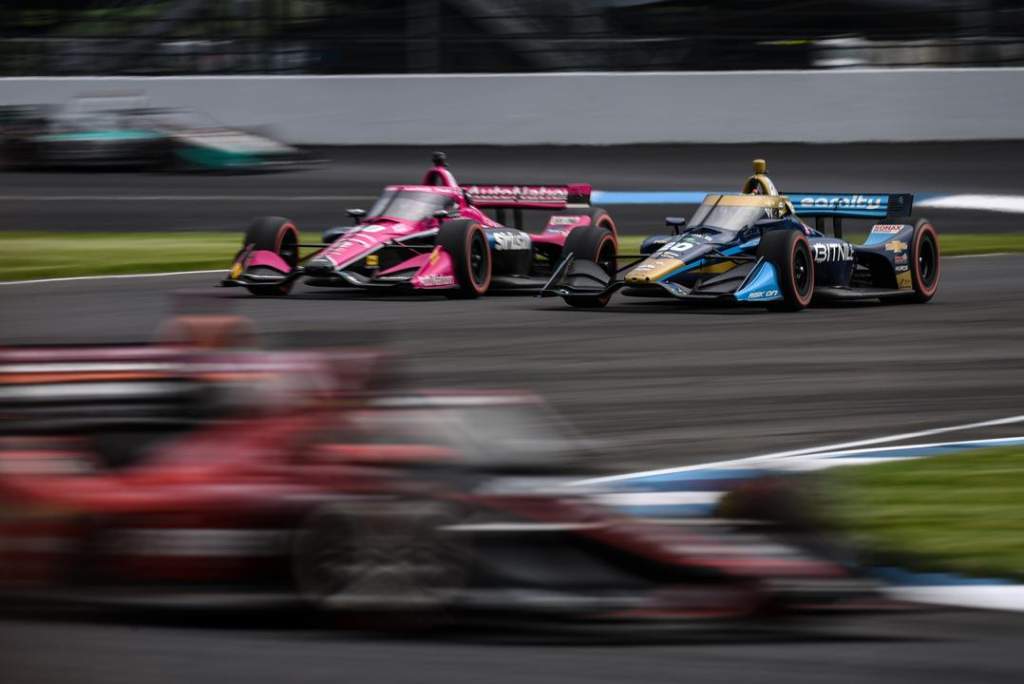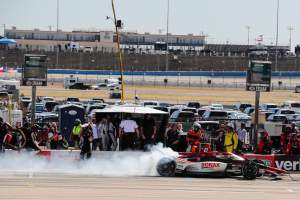Simon Pagenaud has called for IndyCar to introduce a windscreen wiper in the series for conditions like those faced at Indianapolis on Saturday, after the first race use of the aeroscreen in the wet.
The Red Bull Advanced Technologies aeroscreen device using a PPG wrap-around screen has been in use since the start of 2020 as an alternative to the halo most championships use.
It has the added benefit of being able to deflect small debris which can be especially dangerous in oval accidents.
Adding weight high up and at the front of the car added some in-built understeer for teams, and made the cockpit much hotter, but it can’t be denied that it has saved competitors from serious injuries on multiple occasions.
Most recently, a piece of bodywork looked to be heading for Callum Ilott’s head on his oval debut at Texas earlier this year before the device intervened.
Aside from a wet test at Sebring in 2020 when few cars ran and a mildly damp practice session at Mid-Ohio, the aeroscreeen hasn’t faced the challenge of a wet race. The last wet event came before the aeroscreen’s introduction at Detroit in 2019.
“I couldn’t see,” said second-place Indy finisher Simon Pagenaud, who was discussing being behind race leader Colton Herta late-on when conditions were most treacherous.
— The Race (@wearetherace) May 14, 2022
“I didn’t even know where he [Colton Herta, race leader] was, quite frankly. I picked a few points on the fence to know where I had to brake, but it was very difficult to see without the wiper.
“I mean, if we had a wiper, it would probably help, but that was the first real race with the aeroscreen, so you got to give credit to IndyCar. The safety is amazing, but in these conditions, you would need a wiper like they do in the sportscars.
“It’s very similar to a wind screen you have on a sportscar. It’s possible, and it would probably help in these conditions.”
Pagenaud added that he wasn’t being “negative, at all”, more that he was “quite positive about it and what we could do forward to make it even better”.
“As we saw in Texas, it saved I think it was Callum [Ilott]. The aeroscreen saved him. That’s good, and we want to go forward from here. So we’ll find solutions and improve it and make sure that when we have rain races, hopefully, we have more, then we don’t have these issues.
“I’m very thankful that IndyCar let us race. That is something to me in these conditions it shows a different set of skills, and it’s treacherous, but that’s our job to go out there and give the best we can.”
Chip Ganassi Racing’s Marcus Ericsson has been a strong proponent of the screen, saying in 2020 that he felt it’s something F1 should consider implementing.
He reckoned the visibility issues at Indy weren’t canopy related and that any criticism he’d heard should reflect that.
“It’s crazy we haven’t had a race in the wet with the aeroscreen yet, so it was the first test really in proper wet conditions,” he told The Race.
“It was extremely poor visibility, but I think it was more the spray than the aeroscreen. It was just so much spray, especially on the straights.
“I heard a lot of people complain about the aeroscreen but I think it would have been as bad without the aeroscreen.
“In the corners, everything was fine, it was just the spray on the straights that made it dangerous because some of the restarts there you couldn’t see a thing, it was impossible.
“But I’ve had that in F1 as well, they pull up so much water and if there’s too much water on the straight, that’s what happens aeroscreen or not.”
Re aeroscreen after yesterday. My view from my car: it worked well. The visibility issues was coming from all the standing water and spray mainly on the straights. You could hardly see because of it. Done many races in the past in similar conditions with the same problems 1/2
— Marcus Ericsson (@Ericsson_Marcus) May 15, 2022
Conor Daly had his best result of the season in fifth for Ed Carpenter Racing, but he felt he’d had a very specific issue with his device on the car, and, like Pagenaud, wants to see improvements.
“I’ve never seen anything like that before,” he said.
“It was like the water just stayed in the centre of the screen, and I don’t know why, but even as you went faster, which you would hope it would clear, it didn’t.
“Obviously, this is very much a scientific test run. Obviously, we have a lot of data to go through with the series, and I’m sure Jay Frye will look at it as well. And he hates when I talk about the Aeroscreen, but I’m just describing what I saw. That’s all. It was challenging.
“Thankfully, we had a great spotter in Packy Wheeler, who was literally guiding me into Turn 1.
“I couldn’t see the braking zone or the cars in front of me or the end of the pit wall, but I could look out the side of the aeroscreen, so I was looking right and left to go straight, which was neat.”
He later added: “I had to be guided into pitlane, and that’s concerning. Hopefully, we can figure that out, but hopefully we also have very shiny weather for the rest of the year.”







